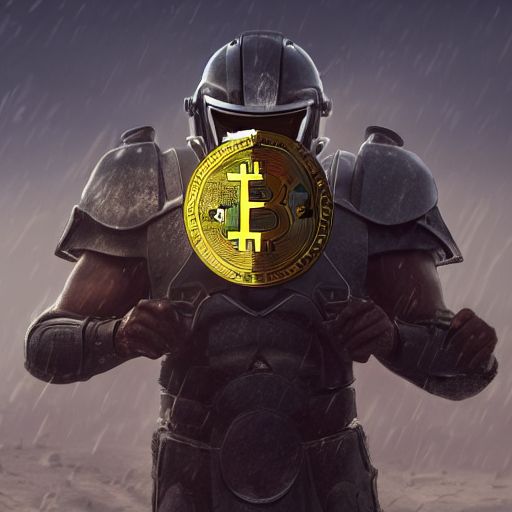Lightning Network in Bitcoin: What is it & How Does it Work?

In Brief
The Lightning Network is a new system for conducting off-chain Bitcoin transactions
Lightning Network nodes are the backbone of the Lightning Network
Bitcoin has had a rocky road since its inception in 2009, but things are looking up for the cryptocurrency thanks to the Lightning Network. This new network could mean big things for Bitcoin’s future, making it faster and more efficient. This guidepost will discuss the Lightning Network and how it works. We will also explore the implications of this new technology for Bitcoin and other cryptocurrencies.

Lighting Network Explained
The Lighting Network is a “Layer 2” payment protocol that runs on top of a blockchain-based cryptocurrency (like Bitcoin). It uses smart contracts to enable instant, high-volume micropayments.
The Lightning Network was first proposed in February 2015 in a whitepaper by Joseph Poon and Thaddeus Dryja. The protocol has been under development by several companies and organizations since then.
Lightning Network nodes can be either “livenets” or “testnets.” Livenets are fully operational networks that are running on the mainnet blockchain, while testnets are used for testing purposes and are not connected to the mainnet blockchain.

Lightning Network nodes have two parts: a “watchtower” and a “wallet.” The watchtower monitors the blockchain for changes affecting the channel’s balance. Meanwhile, the wallet stores the channel’s private keys and signs transactions.
Lightning Network channels are bi-directional. This means that two nodes can send payments to each other in either direction. Both nodes must have funds deposited into the channel for a channel to be open.
The amount of funds that can be stored in a Lightning Network channel is limited by the capacity of the blockchain on which it is running. For example, the Bitcoin blockchain can currently only support channels with a capacity of 0.04 BTC (about $250).

Once a channel is open, both nodes can send payments to each other without having to wait for confirmations from the blockchain. This makes Lightning Network payments much faster than traditional blockchain transactions.
Lightning Network channels can be closed at any time by either party. The current balance is recorded on the blockchain when a channel is closed. This process is called “settlement.”
Settlement usually takes a few minutes. However, it can take longer if the blockchain is congested. Once a channel is settled, all the funds can be withdrawn from the blockchain.
The Lightning Network is still in development and is not yet available on all blockchains. However, it is expected to be supported by most major cryptocurrencies eventually.
How Does the Lightning Network Work?
The Lightning Network is a new system for conducting off-chain Bitcoin transactions. It is designed to allow users to transact with each other without the need for a central authority like a bank. The network comprises nodes, which are computers that connect to the network and relay information about transactions. Nodes can also act as intermediaries, allowing two parties to transact with each other without having to reveal their identities or location.
The Lightning Network can potentially increase the speed and efficiency of Bitcoin transactions. Transactions take up to 10 minutes to confirm. With the Lightning Network, transactions could be confirmed almost instantaneously.
For the Lightning Network to work, each node must have a certain amount of Bitcoin deposited in a “channel.” This deposit serves as collateral and ensures that the node will not cheat or steal any funds. When two nodes want to transact with each other, they first open a channel. Then, they can conduct as many transactions as they want within that channel. Finally, they close the channel and transfer the Bitcoin to the correct addresses.

The Lightning Network was first proposed in 2015 by Joseph Poon and Thaddeus Dryja in their whitepaper “The Bitcoin Lightning Network: Scalable Off-Chain Instant Payments.” The basic idea is to use “payment channels” to allow two parties to transact multiple times without recording each transaction on the blockchain.
For this to work, both parties need to lock up some of their coins in a multi-signature (aka “multi-sig”) wallet. This wallet can be considered an “escrow account” that requires both parties to sign off on any withdrawals.
Once the coins are locked up, the two parties can make as many transactions as much as they want without touching the blockchain. They can close out the payment channel anytime and withdraw their remaining balance.
The only time the blockchain comes into play is when the payment channel is first created (to lock up the coins) and when it’s closed (to settle the final balance). Lightning Network transactions are much faster and cheaper than regular Bitcoin transactions since they don’t need to be verified.
What Makes the Lightning Network So Great?
The Lightning Network is a new technology that has the potential to improve the Bitcoin network significantly. It allows for near-instant, low-fee transactions and can be used to make micropayments. The Lightning Network can also be used to create smart contracts. As it can route payments through multiple channels, it reduces congestion on the blockchain.
One of the key features of the Lightning Network is its scalability. The network can theoretically scale to millions of transactions per second, more than the Bitcoin network handles. This would allow Bitcoin to be used for much more than just payments; it could become a platform for all sorts of applications.

Another great feature of Lightning Network is its privacy. Since transactions are not broadcast to the entire network, they are much more private than regular Bitcoin transactions. This is important for people who want to use Bitcoin for illegal or sensitive activities.
Lightning Network also has the potential to improve the decentralization of Bitcoin. Currently, most Bitcoin transactions go through a few large exchanges and wallets. Lightning Network could allow users to transact directly with each other without having to use a central intermediary. This would make it much harder for any entity to control or censor the Bitcoin network.
All of these features make Lightning Network a fascinating technology. It can potentially improve the Bitcoin network in several ways and help make Bitcoin a more widely used and accepted currency.
What are some of Lightning Network’s use cases?
Lightning Network can be used for several different purposes, including but not limited to:
- Peer-to-peer payments: The Lightning Network allows for fast, cheap, and secure P2P payments. This could be used for online shopping, sending money to friends or family, or even paying for goods and services in brick-and-mortar stores.
- Decentralized exchanges: The Lightning Network can be used to facilitate trustless, decentralized exchanges of cryptocurrencies. This could potentially lead to the creation of new types of decentralized exchanges that are much faster and more efficient than traditional ones.
- Micropayments: The Lightning Network is well suited for micropayments due to its low fees and fast transaction times. This could be used for online tipping, pay-per-click advertising, or even microtransactions within games or other applications.
- IoT payments: The Lightning Network could be used to facilitate payments between devices on the Internet of Things (IoT). This would allow for near-instantaneous and very cheap payments between devices, which could have a number of potential use cases.
- Smart contracts: The Lightning Network can be used to create and execute smart contracts. This could be used for many applications, from simple escrow services to more complex applications like decentralized exchanges or lending platforms.
- Cross-chain atomic swaps: The Lightning Network can be used to facilitate trustless, cross-chain atomic swaps. This would allow for the exchange of cryptocurrencies without the need for a third party and could potentially lead to the creation of new types of decentralized exchanges.
These are just some of the potential use cases for the Lightning Network. As the technology continues to develop, new and innovative use cases will be discovered.
Cons of Lightning Network
There are potential security risks that come with using the Lightning Network. These risks are large since the network is still in its early stages of development and has not been thoroughly tested. Additionally, there is the potential for loss of funds if a user’s node goes offline or if there is a software bug. While these risks are not unique to the Lightning Network, they may be more pronounced due to the additional layer of complexity introduced by the network.
Another potential downside of the Lightning Network is that it could centralize power within the network. This could happen if a few nodes control a large portion of the network’s capacity. This could lead to increased fees and less competition within the network.

Additionally, some have raised concerns that the Lightning Network could be used to launder money or facilitate other illegal activities. While it is possible to use the network for these purposes, it is also possible to use regular Bitcoin transactions for these activities.
Overall, the Lightning Network can potentially improve the efficiency of Bitcoin transactions significantly. However, some risks and challenges still need to be addressed before the network can be fully realized.
What are Lightning Network nodes?
Lightning Network nodes are the backbone of the Lightning Network. They are responsible for routing payments and maintaining the network. Anyone can run nodes, and there is no central authority. Nodes earn fees from routing payments and charge additional fees for certain payments.
Nodes are connected through a network of peer-to-peer channels. When a payment is made, the nodes route the payment through the network until it reaches its destination. Along the way, each node takes a small cut of the transaction fee.
Lightning Network nodes provide an important service to the network and are rewarded for their efforts with fees. Running a node is a good way to earn income from the Lightning Network.
If you are interested in running a Lightning Network node, there are a few things you need to know. First, you need to have a full Bitcoin node. This will give you the ability to create channels and route payments. Second, you need to run the Lightning Network Daemon (LND), the software that manages channels and routes payments. Finally, you need to connect your node to other nodes in the network. The more nodes you are connected to, the more payment options you will have and the more fees you can earn.
Running a Lightning Network node is a great way to support the network and earn income. If you are ready to get started, check out our guide to setting up a Lightning Network node.
What Is a Lightning Payment Channel?
A Lightning payment channel is a two-way channel between two nodes on the Lightning Network. Nodes can open and close channels at will, and each channel has its unique deposit. The deposit remains in the channel until it is closed, at which point it is either refunded to the original depositor or given to the counterparty as a fee.

Lightning payments are made by creating “commitments” to spend funds from the channel’s deposit. These commitments are signed by both parties and can be revoked at any time. Revoked commitments are then replaced with new commitments, which can be used to make payments.
The net result of this process is that payments can be made without having to move any money around on the blockchain. This makes Lightning payments much faster and cheaper than traditional Bitcoin transactions.
Lightning channels can be thought of as mini-blockchains that exist outside of the main Bitcoin blockchain. This allows Lightning payments to be made without waiting for confirmations from miners.
Lightning channels don’t necessitate a central server or controller, meaning they can be created between any two nodes on the Lightning Network. This makes the Lightning Network more decentralized and less likely to succumb to attacks.
How to Open a Lightning Payment Channel?
Opening a Lightning payment channel requires two nodes to deposit funds into a multisig wallet. These funds are then locked up until the channel is closed.
The process of opening a channel is as follows:
1. Node A and Node B each deposit an equal amount of bitcoins into a multisig wallet. The total amount deposited must be greater than or equal to the channel’s capacity.
2. Node A and Node B sign a commitment transaction that allows them to spend the funds in the multisig wallet. This commitment transaction is not broadcast to the blockchain.
3. Node A and Node B both have a copy of the commitment transaction. They can now pay each other by creating and signing new commitment transactions.
4. When either node wants to close the channel, they broadcast the most recent commitment transaction to the blockchain. This unlocks the funds and allows them to be spent.

Lightning payment channels can be used to make unlimited payments if both nodes have enough funds deposited. The only limit is the channel’s capacity, which is set when the channel is created.
Bitcoin Lightning Wallet on Android
The Bitcoin Lightning Wallet for Android is an app that allows you to store, send, and receive bitcoins. It is one of the most popular wallets available and has been downloaded over 1 million times. The wallet is available in English, Spanish, French, and Chinese.
The wallet has a user-friendly interface and is very easy to use. It has many security features, including 2-factor authentication and a passcode lock. The wallet supports multiple currencies, including BTC, ETH, LTC, and BCH. You can also exchange between these currencies easily.
Overall, the Bitcoin Lightning Wallet on Android is a great option for anyone looking for a secure and easy-to-use Bitcoin wallet.

Many Bitcoin wallets are available on Android, but few support the Lightning Network. Here’s a list of some of the best Lightning-compatible wallets for Android.
1. BlueWallet
BlueWallet is a popular Bitcoin wallet that also supports the Lightning Network. It has a simple interface and is easy to use. BlueWallet also allows you to buy and sell Bitcoin directly from the app.
2. Eclair Wallet
Eclair Wallet is another popular Lightning-compatible Bitcoin wallet for Android. It has a sleek interface and is easy to use. Eclair also allows you to buy and sell Bitcoin directly from the app.
3. Zap Wallet
Zap Wallet is one of the newer Lightning-compatible Bitcoin wallets for Android. It has a simple interface and is easy to use. Zap also allows you to buy and sell Bitcoin directly from the app.
4. Lightning Wallet
Lightning Wallet is a popular Lightning-compatible Bitcoin wallet for Android. It has a simple interface and is easy to use. Lightning Wallet also lets you buy and sell Bitcoin directly from the app.
5. Boltzmann Wallet
Boltzmann Wallet is another new Bitcoin wallet for Android. It has an attractive interface and is easy to use. Boltzmann also allows you to buy and sell Bitcoin directly from the app.
These are just a few of the many Lightning-compatible wallets available for Android. Be sure to research any wallet you’re considering before downloading it. And always remember to keep your Bitcoin private keys safe and secure.
FAQs
Lightning Network is a decentralized network of payment channels that enables instant, low-cost Bitcoin (BTC) transactions. The Lightning Network is built on top of the Bitcoin blockchain and can be used to make fast, cheap, and private payments.
Nodes in the lightning network link up by creating “channels.” Channels are created when two nodes connect and put some amount of bitcoin into a shared escrow account.
To use the Lightning Network, you must connect to a node running LND. There are many public LND nodes that you can connect to, or you can run your node if you wish. Once connected to an LND node, you can open and close channels, send and receive payments, and more.
Lightning Network nodes are the backbone of the Lightning Network, providing the infrastructure necessary for facilitating instant, low-cost payments. Nodes can be operated by anyone and are typically run on dedicated hardware or virtual private servers.
Lightning routing is a key part of the Lightning Network, a decentralized network that allows for near-instant, low-fee payments. Lightning routing works by creating a network of nodes, each of which holds some amount of bitcoin. When a user wants to make a payment, they create a “channel” with one of these nodes and then send their payment through that channel.
Conclusion
The Lightning Network is a new way to process Bitcoin transactions that could potentially speed up the network and reduce fees. It works by creating a second layer on top of the Bitcoin blockchain that can handle small, fast transactions.
Read related posts:
Disclaimer
In line with the Trust Project guidelines, please note that the information provided on this page is not intended to be and should not be interpreted as legal, tax, investment, financial, or any other form of advice. It is important to only invest what you can afford to lose and to seek independent financial advice if you have any doubts. For further information, we suggest referring to the terms and conditions as well as the help and support pages provided by the issuer or advertiser. MetaversePost is committed to accurate, unbiased reporting, but market conditions are subject to change without notice.
About The Author
Damir is the team leader, product manager, and editor at Metaverse Post, covering topics such as AI/ML, AGI, LLMs, Metaverse, and Web3-related fields. His articles attract a massive audience of over a million users every month. He appears to be an expert with 10 years of experience in SEO and digital marketing. Damir has been mentioned in Mashable, Wired, Cointelegraph, The New Yorker, Inside.com, Entrepreneur, BeInCrypto, and other publications. He travels between the UAE, Turkey, Russia, and the CIS as a digital nomad. Damir earned a bachelor's degree in physics, which he believes has given him the critical thinking skills needed to be successful in the ever-changing landscape of the internet.
More articles

Damir is the team leader, product manager, and editor at Metaverse Post, covering topics such as AI/ML, AGI, LLMs, Metaverse, and Web3-related fields. His articles attract a massive audience of over a million users every month. He appears to be an expert with 10 years of experience in SEO and digital marketing. Damir has been mentioned in Mashable, Wired, Cointelegraph, The New Yorker, Inside.com, Entrepreneur, BeInCrypto, and other publications. He travels between the UAE, Turkey, Russia, and the CIS as a digital nomad. Damir earned a bachelor's degree in physics, which he believes has given him the critical thinking skills needed to be successful in the ever-changing landscape of the internet.























































